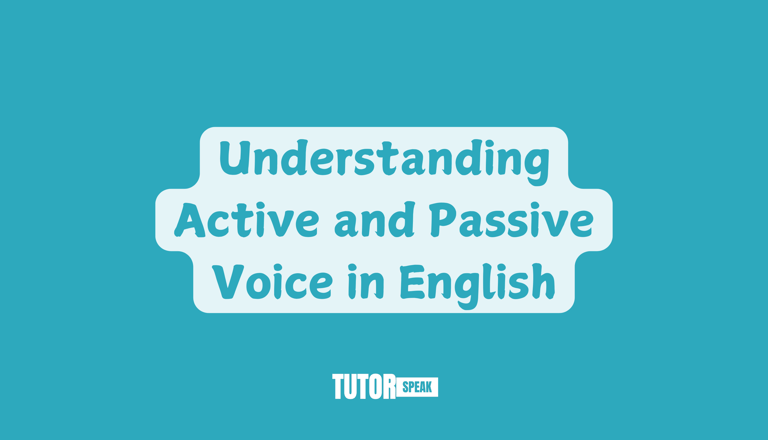Understanding Active and Passive Voice in English
In English, sentence construction plays a crucial role in communication. Two common types of sentence structures are active and passive voice. Understanding the difference between these two voices can significantly improve clarity and precision in writing.
TutorSpeak
12/9/20244 min read


Understanding Active and Passive Voice in English
In English, sentence construction plays a crucial role in communication. Two common types of sentence structures are active and passive voice. Understanding the difference between these two voices can significantly improve clarity and precision in writing.
What is Active Voice?
In active voice, the subject of the sentence performs the action. The sentence typically follows a clear structure of Subject + Verb + Object.
Example:
The teacher explains the lesson.
Here, "the teacher" (subject) is performing the action (explains) on the object (the lesson). Active voice is often preferred for its clarity and directness, especially in situations where the performer of the action is important.
What is Passive Voice?
In passive voice, the object of the action becomes the subject of the sentence, and the doer of the action may or may not be mentioned. The structure of a passive sentence is typically Subject + Form of 'to be' + Past Participle of the Verb.
Example:
The lesson is explained by the teacher.
In this sentence, "the lesson" becomes the subject, and the focus shifts from the doer (the teacher) to the action and the recipient of that action. The passive construction is particularly useful when the performer is unknown, unimportant, or implied.
When to Use Active Voice
Active voice is more commonly used in English and tends to be preferred in many situations. It is often used in:
Narrative writing: To clearly state who is doing what.
Instructions and guides: To provide clear and direct commands.
Scientific writing: When clarity and simplicity are vital.
Example:
The team completed the project on time.
Here, the focus is on the team’s accomplishment, and the sentence is direct and easy to understand.
When to Use Passive Voice
While active voice is favored in most cases, passive voice has its own uses:
When the action is more important than the doer:
The law was passed last year.
When the doer is unknown or irrelevant:
The window was broken.
In formal or academic writing: Passive voice is often used to shift the focus from the doer to the action or result, especially when the performer of the action is less important.
The experiment was conducted by researchers to test the hypothesis.
Converting Active Voice to Passive Voice
To convert an active sentence to passive, follow these simple steps:
Identify the subject, verb, and object in the active sentence.
Make the object of the active sentence the subject of the passive sentence.
Change the verb: Use the correct form of the verb "to be" and the past participle of the main verb.
Add the doer of the action (if necessary) using "by."
Example:
Active: The chef cooked the meal.
Passive: The meal was cooked by the chef.
Advantages and Disadvantages
Active voice is more straightforward and often more engaging. It places emphasis on the subject (the performer).
Passive voice can be useful for shifting emphasis to the action or the recipient of the action, especially when the doer is unknown, unimportant, or implied.
However, overuse of passive voice can make writing seem impersonal or overly complex. It may obscure who is performing the action, making the writing harder to follow.
Exercise 1: Identify the Voice
Read the following sentences and identify whether they are in active or passive voice. Write “Active” or “Passive” next to each sentence.
The book was read by Sarah.
The students completed their assignments on time.
The new law was enacted last month.
The teacher will give a lecture tomorrow.
The cake was eaten by the children.
The committee is reviewing the proposal.
The painting was created by the artist in 1920.
The police arrested the suspect yesterday.
Exercise 2: Convert Active to Passive
Rewrite the following active voice sentences in passive voice.
The manager approved the new project.
The children played the game in the park.
The company will launch a new product next year.
The chef prepared a delicious dinner for the guests.
The scientists discovered a new species of bird.
The team won the championship last season.
The author wrote a bestseller last year.
The teacher is giving a test tomorrow.
Exercise 3: Convert Passive to Active
Rewrite the following passive voice sentences in active voice.
The homework was completed by the students.
The prize was won by a lucky participant.
The song was sung by a famous singer.
The letter was delivered yesterday.
The decision was made by the committee.
The project was completed on time by the team.
The books were arranged on the shelf by the librarian.
The email was sent by my colleague.
Exercise 4: Fill in the Blanks with the Correct Voice
Choose whether to use the active or passive form of the verb in the following sentences.
The report __________ (submit) yesterday.
The workers __________ (complete) the task by next week.
A delicious dinner __________ (cook) by the chef right now.
The book __________ (write) by a famous author.
The children __________ (teach) to swim every summer.
The final decision __________ (make) by the committee tomorrow.
The meeting __________ (arrange) by the secretary this morning.
The house __________ (build) by a construction company.
Exercise 5: Rewrite the Sentences with Emphasis on the Action
Rewrite the following sentences to focus on the action rather than the doer. Use the passive voice.
The teacher explained the rules.
The police officer caught the thief.
The chef cooked the meal.
The student answered the question correctly.
The company announced the new policy.



